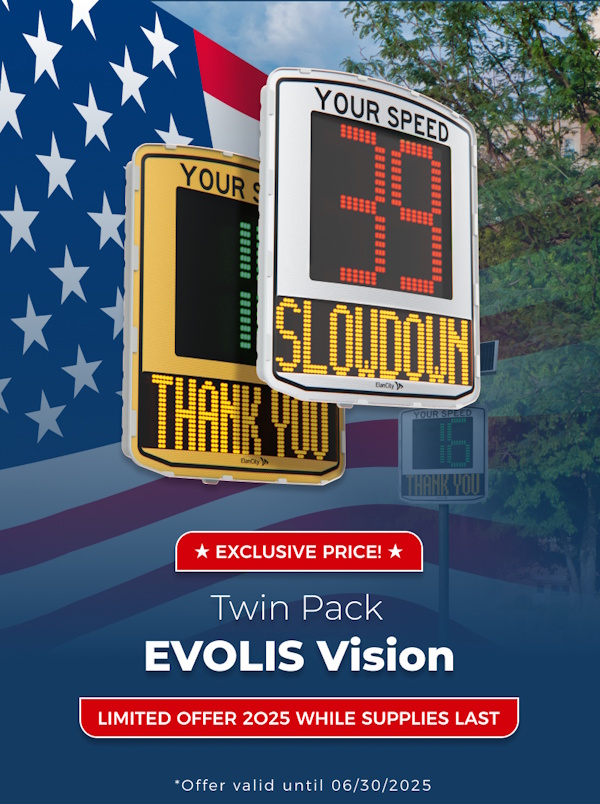Ensure Work Zone Safety with Speed Indicator Devices
Busy roads pose significant safety risks for corporate, commercial, industrial and warehouse work zones with heavy foot traffic flows.
Installing speed indicator devices in these high-traffic areas can significantly enhance safety by alerting drivers when they exceed the speed limit. Our systems offer effective traffic-calming solutions, creating a safer environment for employees, pedestrians and drivers alike. In addition to improving physical safety, these display radar signs foster a culture of cautious driving that will support your corporate responsibility goals.
Reduce speeding in your car parks and delivery and warehouse areas
In large delivery areas and lorry parks, different types of vehicles and pedestrians often cross paths. The risks in such areas are heightened by the “force of habit” effect, which can make drivers less attentive due to familiary and routine.
Adopting a long-term preventive strategy can reduce speeding and accidents, reinforcing safety in these work zones.
The bottom line: Radar speed signs offer a safer future for your staff members and colleagues.
The evidence speaks for it self: Notifying drivers of their current speed results in an immediate speed decrease of 25%, with sustained results.
Elan City’s radar speed sign
Opting for an Elan City radar speed indicator device means choosing a guarantee of uncompromising quality. With over 30,000 devices in operation worldwide, our products have helped boost safety standards in numerous factories and work sites across a diverse range of industries.
Elan City offers self-contained (solar-powered) products designed for effortless single-person installation, with an impact even in areas where vehicles move as slowly as 9 or 12 miles per hour – the ideal solution for improving employee safety!
Are speed indicator signs effective at low speeds?
Radar traffic signs are highly effective at monitoring and regulating vehicle speeds even as low as 9 miles per hour.
They represent an essential solution in areas where safety risks are posed by a mix of slow-moving traffic, pedestrians and confined spaces. By providing real-time feedback to drivers about their current speed, radar speed signs encourage safer driving habits, reducing the potential for accidents and ensuring a secure environment for employees in areas with varying traffic speeds such as depots, car parks, storehouses and warehouses.
How do speed indicator devices work? Are their results proven?
When drivers are alerted to their current speed, an immediate and sustained slow-down occurs, typically resulting in an average speed decrease of 25%.
To ensure a lasting impact, specific measures can be taken to prevent drivers from becoming desensitised to speed signs and their effects:
1. Relocation of speed indicator devices: Our lightweight and portable signs can be moved to different locations with ease in order to target high-risk areas. This approach enables coverage of multiple work zones, such as warehouses, storehouses and depots, while facilitating the collection of new data and maintaining driver awareness of speed limits.
2. Customised display messages: Reinforce work zone safety by incorporating specific messages such as “danger ahead” when drivers exceed the speed limit. This provides an additional prompt to alert drivers to slow down.
3. Activation of spy mode: When spy mode is activated, the radar speed sign continues recording speed data even when the display is inactive. This enables you to compare driver behaviour with and without the speed indicator visible, offering valuable insights into long-term impacts on traffic behaviour.
Is a speed indicator device robust? What about vandalism?
Built with a robust, single-piece design using reinforced ABS-Polycarbonate resin, the pole-mounted EVOLIS Radar Speed Indicator Sign is both sturdy and waterproof. This solid construction ensures that the sign is highly durable and resistant to the elements, as well as vandalism.
For additional security, the product comes with a two-year warranty for total peace of mind.
What is the ideal location for installing my radar speed display?
Optimum placement: Speed signs should be placed in areas where speeding poses a major problem, as demonstrated by a high incidence of road accidents or numerous complaints about speeding from employees.
Safety and regulatory guidelines for installation:
- Install the radar on the right-hand side of the road facing oncoming traffic. Make sure it is aligned as close to perpendicular of the road axis as possible.
- Ensure the speed indicator device is mounted at a height of at least 2.3 metres to avoid obstructing pedestrian pathways.
Important installation metrics:
- For optimal performance, place the radar speed sign along a straight segment of road that extends at least 200 metres – the distance from which the radar is visible to drivers.
- The radar’s Doppler antenna can detect oncoming vehicles from as far as 300 metres away.
- The speed display updates every 1.1 seconds, providing near real-time feedback to drivers.
What power sources are available? Which one should I choose?
According to our data, 80% of local authorities who have installed a speed indicator device prefer the solar option for its convenience and energy efficiency.
Power source options:
Solar connection: The solar-powered radar speed sign is fully self-sufficient, equipped with two backup batteries and powered by a 95-watt photovoltaic panel, ensuring continuous power all year round.
Electric: The radar speed display can operate on a constant electric current or connect to the public lighting network, with a minimum requirement of five hours of nightly charging.
Dual power: This option integrates both solar and electrical connections, ensuring a dependable backup power source. If solar power is insufficient due to low levels of sunlight, the system can switch to electric power. Similarly, solar power can act as a backup if the public lighting network fails to provide the necessary five hours of charging.
Batteries: The system includes two batteries and an external charger, providing between seven and ten days of autonomy.






